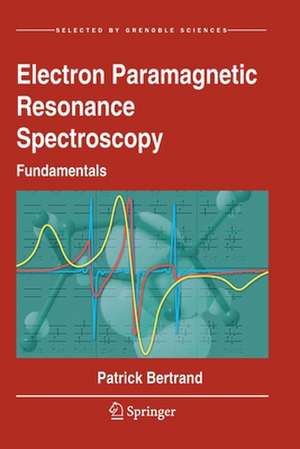Electron Paramagnetic Resonance Spectroscopy: Fundamentals
Autor Patrick Bertranden Limba Engleză Paperback – 4 feb 2021
| Toate formatele și edițiile | Preț | Express |
|---|---|---|
| Paperback (2) | 496.39 lei 43-57 zile | |
| Springer International Publishing – 4 feb 2021 | 496.39 lei 43-57 zile | |
| Springer International Publishing – 4 feb 2021 | 497.37 lei 43-57 zile | |
| Hardback (2) | 597.66 lei 43-57 zile | |
| Springer International Publishing – 4 feb 2020 | 597.66 lei 43-57 zile | |
| Springer International Publishing – 4 feb 2020 | 598.50 lei 43-57 zile |
Preț: 496.39 lei
Nou
Puncte Express: 745
Preț estimativ în valută:
94.98€ • 99.44$ • 78.59£
94.98€ • 99.44$ • 78.59£
Carte tipărită la comandă
Livrare economică 07-21 aprilie
Preluare comenzi: 021 569.72.76
Specificații
ISBN-13: 9783030396657
ISBN-10: 3030396657
Pagini: 420
Ilustrații: XXIV, 420 p. 2 illus., 1 illus. in color.
Dimensiuni: 155 x 235 x 23 mm
Greutate: 0.62 kg
Ediția:1st ed. 2020
Editura: Springer International Publishing
Colecția Springer
Locul publicării:Cham, Switzerland
ISBN-10: 3030396657
Pagini: 420
Ilustrații: XXIV, 420 p. 2 illus., 1 illus. in color.
Dimensiuni: 155 x 235 x 23 mm
Greutate: 0.62 kg
Ediția:1st ed. 2020
Editura: Springer International Publishing
Colecția Springer
Locul publicării:Cham, Switzerland
Cuprins
Preface.- Fundamental constants - Units conversion.- The electron paramagnetic resonance phenomenon.- Hyperfine structure of the spectrum in the isotropic regime.- Introduction to the spin states space formalism.- Consequences of the anisotropy of G and A matrices on the shape of spectra given by radicals and transition ions complexes.- Intensity of the spectrum, saturation, spin-lattice relaxation.- Zero field splitting. EPR spectra given by paramagnetic centers with spin greater than ½.- Effect of dipolar and exchange interactions on the EPR spectrum - Biradicals and polynuclear complexes.- EPR spectra given by rare earth and actinide complexes.- Effect of instrumental parameters on the shape and intensity of the spectrum - Introduction to numerical simulation techniques.
Recenzii
“The book targets graduate students and researchers who are interested in acquiring the broad background knowledge needed to interpret the spectra and understand the applications of EPR technique. A set of problems, with hints to solutions, covers a wide range of difficulty.” (Christian Brosseau, Optics & Photonics News, osa-opn.org, October 1, 2020)
Notă biografică
Patrick Bertrand received his undergraduate education at the Ecole Centrale de Paris. He received his PhD in physics in 1977 and his doctorat es sciences in 1981. Since 1989, he has been a Professor at the Université de Provence, now Aix-Marseille University. He is a well-known specialist in the applications of EPR spectroscopy to the study of electron-transfer proteins and redox enzymes. He is the author of over a hundred publications and several books in this field.
Textul de pe ultima copertă
Although originally invented and employed by physicists, electron paramagnetic resonance (EPR) spectroscopy has proven to be a very efficient technique for studying a wide range of phenomena in many fields, such as chemistry, biochemistry, geology, archaeology, medicine, biotechnology, and environmental sciences. Acknowledging that not all studies require the same level of understanding of this technique, this book thus provides a practical treatise clearly oriented toward applications, which should be useful to students and researchers of various levels and disciplines. In this book, the principles of continuous wave EPR spectroscopy are progressively, but rigorously, introduced, with emphasis on interpretation of the collected spectra. Each chapter is followed by a section highlighting important points for applications, together with exercises solved at the end of the book. A glossary defines the main terms used in the book, and particular topics, whose knowledge is not required for understanding the main text, are developed in appendices for more inquisitive readers.
Caracteristici
Presents a novel didactic approach for understanding and using EPR spectroscopy Covers the necessary fundamentals of the topic with a focus on experimental application Features a progressive and rigorous treatment with a glossary of terms, many appendices, and solved exercises
